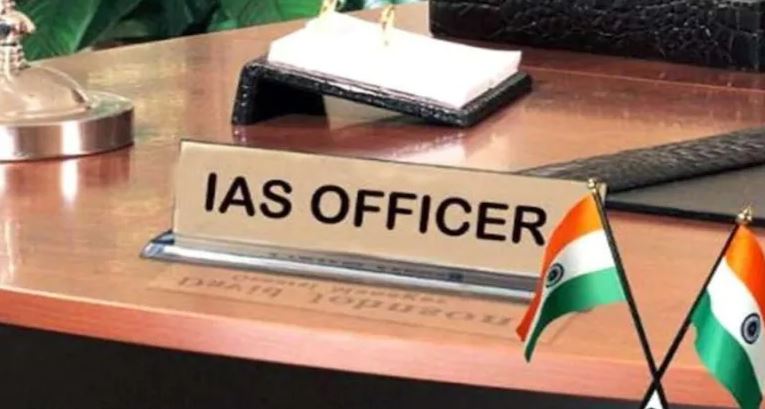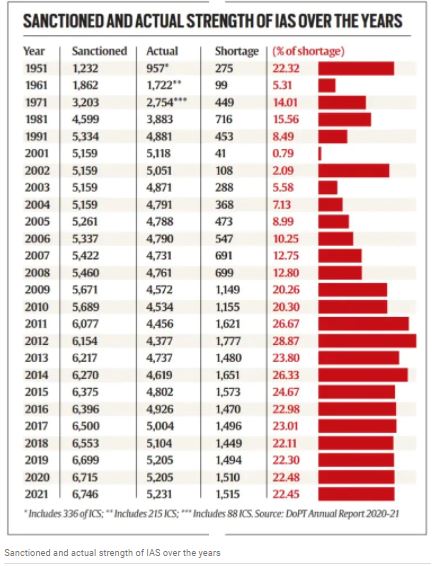Large number of vacancies in the IAS – Reasons and Impacts


This topic of “Large number of vacancies in the IAS – Reasons and Impacts” is important from the perspective of the UPSC IAS Examination, which falls under General Studies Portion.
Context
Real VS Sanctioned Strength of IAS Officers in the Country
- India has about 22 per cent fewer IAS officers than the sanctioned strength.
- According to the Minister of State for PMO; Personnel, Public Grievances and Pensions, as of January 1, 2021, there were 5,231 IAS officers in the country — 1,515 (22.45 per cent) fewer than the sanctioned strength of 6,746.
- A total of 3,787 officers were direct recruits to the IAS, while 1,444 were promotees (State Civil Services/ non-SCS).
- The Department-Related Parliamentary Standing Committee on Public Grievances, Law and Justice in its 112th report tabled in both Houses of Parliament pointed out that there is a huge shortage.
- The gap between the sanctioned strength and the in-position strength of IAS officers is as large as 104 in UP cadre, 94 in Bihar cadre and 87 in AGMUT cadre.
Is the shortage a new trend?
Constant Feature
- The shortage has been a constant feature ever since.
- Even in 1951, there were 957 officers, including 336 from the Indian Civil Service (ICS), against a sanctioned strength of 1,232 — which means 275, or 22.32 per cent, seats were vacant.
- It was the least in 2001 (0.79 per cent), and the most in 2012 (28.87 per cent), as per available data.
How is the sanctioned strength decided?
The Cadre Review Committee and Quinquennial Cadre Reviews
- There is a provision for quinquennial cadre reviews for every cadre of the All-India Services under the relevant Cadre Rules.
- The Cadre Review Committee (CRC) is headed by the Cabinet Secretary with the Secretary DoPT, Secretary Expenditure, Secretary Administrative Ministry, and the senior-most member of the service/cadre in question as its members.
- Cadre review is an ongoing process, and some states are taken up by rotation every year for review.
- In 2020-21, for example, it was decided to revise the strength and composition of the IAS in UP and Bihar, and of the IPS in Manipur.
- The sanctioned strength, therefore, keeps changing.
How are officers recruited in the IAS?
Direct Recruits
- Direct recruits are selected through the Civil Service Examination (CSE) every year.
- The number of recruits is decided by a committee that takes several factors into account.
- Since 2012, 180 IAS officers have been recruited every year through the CSE.
- A committee has been constituted to arrive at a suitable formula to determine the intake of IAS officers every year from CSE-2022 to 2030.
Promotion/Induction from the State Civil Services
- Some officers are promoted from the State Civil Services (SCS), and a limited number are promoted from among non-SCS officers.
- Filling vacancies through induction from State Services is a continuous process.
- The Union Public Service Commission (UPSC) holds Selection Committee meetings with state governments.
What impact can a shortage of IAS officers have?
High level of responsibilities
- IAS officers are given a wide range of high-level responsibilities.
- In states, their work relates to the collection of revenue, maintenance of law and order, and supervision of policies of the central and state governments.
- They function as executive magistrates in revenue matters, and as development commissioners.
- They supervise the spending of public funds and, at a senior level, contribute to policy formulation and decision-making in consultation with Ministers.
- They serve the central government under deputation.
Bureaucracy deficit and Efficiency of administration
- Bureaucracy deficit is, perhaps, compelling states to take recourse to such means as appointing non-cadre officers to cadre posts.
- States allow them to continue in such posts beyond the permissible time limit besides giving multiple charges to serving officers.
- Such measures compromise the efficiency of administration.
Why not we increase, if a reduced number of IAS officers is the issue?
The BS Baswan Committee
- In its report submitted in 2016, the BS Baswan committee said that “any number above 180 would
- Compromise quality
- Exceed the LBNSAA’s capacity
- Lead to a distortion in the career pyramid of IAS officers, particularly for senior posts in the Government of India
- The Committee recommended that “vacant posts in the Centre and states can be filled by deputation where the number of deputationists would be less than the present.”
What can be a way forward?
Recommendation of the Parliamentary Committee led by Sushil Modi in its 112th Report
- Considering the national interest and the evolving needs of modern democracy and the Indian administration, it is high time for the DoPT to increase the annual intake of IAS officers.
Practice Question for Mains
- Considering the national interest and the evolving needs of modern democracy and the Indian administration, it is high time for the DoPT to increase the annual intake of IAS officers. Examine. (150 Words, 10 Marks)
Referred Sources


